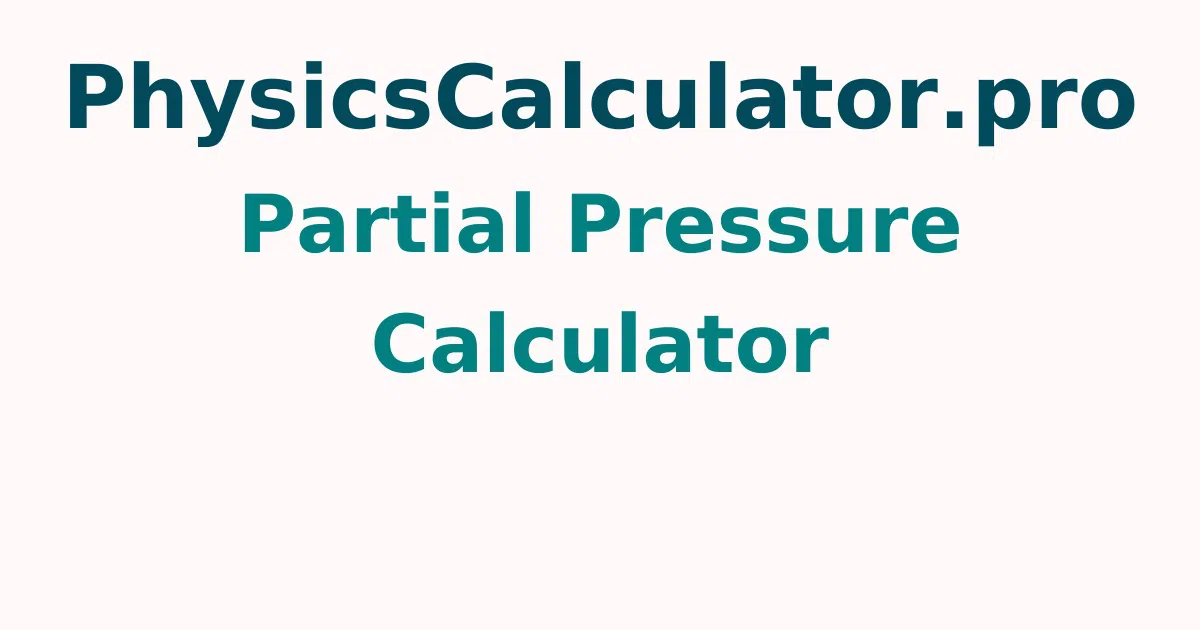Partial Pressure Calculator
The Partial Pressure Calculator is a simple tool for calculating and understanding the partial pressure of gases. The partial pressures are calculated using Henry's Law, Ideal Gas Law, and Dalton's Law. To quickly check the result, simply enter the required information and press the calculate button.
Partial Pressure Calculator: Here is one of the best tools for quickly calculating the partial pressure of any gas. It provides precise results in a short amount of time. For all of these laws, you can learn the law of partial pressures, which includes ideal gas law, Dalton's law, Henry's law, and partial pressure formulas. Learn how to calculate partial pressure using simple steps and get answers to questions about it.
What Does Partial Pressure Mean?
Partial pressure is used in chemistry to determine the movement of gas. It is defined as the force exerted by a substance in the gaseous state. The mole fraction of the gas in the mixture is the simplest way to determine the partial pressure. Different fields, such as physics, chemistry, and biology, use partial pressure.
The partial pressure value can be used to determine the levels of carbon dioxide and oxygen in the blood. According to Dalton's law, The total pressure of an ideal gas mixture is equal to the sum of the partial pressures of individual gases.
Dalton's Law of Partial Pressure
As per Dalton's partial pressure law, The total pressure applied on a container wall by a gas mixture equals the sum of the partial pressures of each individual gas.
The equation is total pressure = p1 + p2 + . . pn
The partial pressures of each gas component are denoted by the letters p1, p2,..., pn.
partial pressure = total pressure x mole fraction
Where,
The mole fraction is the proportion of moles of a specific gas to the total gas mixture's moles.
Calculating Partial Pressure Using Ideal Gas Law
According to the ideal gas law, p * V = n * R * T.
p = (n * R * T)/V is the partial pressure equation.
Where,
- p = partial pressure of the gas
- V = volume of the gas
- n = number of moles of the gas
- R = universal gas constant, 8.3145 J/mol K
- T = temperature of the gas
Henry's Law - Partial Pressure Formula
The partial pressure of a gas above a liquid is proportional to the amount of gas dissolved in the liquid, according to Henry's law. Henry's constant is the proportionality coefficient.
When we have a concentration of the solute, we use Henry's law method 1.
KH1 x concentration = pressure
When the mole fraction of the solute is known, Method 2 is used.
KH2 x mole fraction = pressure
Where,
Henry's law constant (litre x atm/mol) is KH1.
Henry's law constant in atm is KH2.
| Element | Henry's law constant [litre*atm/mol] | Henry's law constant [atm] |
|---|---|---|
| O2 | 769.23 | 4.259*104 |
| H2 | 1282.05 | 7.099*104 |
| Co2 | 29.41 | 0.163*104 |
| N2 | 1639.34 | 9.077*104 |
| He | 2702.7 | 14.97*104 |
| Ne | 2222.22 | 12.3*104 |
| Ar | 714.28 | 3.955*104 |
| CO | 1052.63 | 5.828*104 |
How to Determine Partial Pressure?
The steps to easily calculate the partial pressure of gases are as follows.
Dalton Law:
- Step 1: From the question, determine the total pressure and mole fraction.
- Step 2: To determine the partial pressure, multiply the total pressure by the mole fraction.
Ideal Gases Law:
- Step 1: The number of moles, the temperature, and the volume should all be known.
- Step 2: Combine the number of moles, the temperature, and the universal gas constant.
- Step 3: To find the partial pressure of ideal gases, divide the product by the volume of the gas.
Henry Law:
- Step 1: Find the name of the gas as well as the mole fraction or concentration.
- Step 2: Multiply the concentration by the Henry law constant.
- Step 3: Alternatively, multiply the mole fraction by the constant.
How Do I Use the Partial Pressure Calculator?
The following is the procedure how to use the partial pressure calculator:
Step 1: In the input field, enter the mole fraction of the solution and the Henry constant for the mole fraction.
Step 2: To get the result, click the "Calculate Partial Pressure" button.
Step 3: In the output field, the partial pressure calculated using the mole fraction of the solute will be displayed.
FAQs on Partial Pressure Calculator
1. What is the formula for calculating partial pressure from flow rate?
To begin, use the ideal gas law pv=nrt at the desired temperature to calculate the total pressure. After that, pressure is directly proportional to n, you can use Dalton's Law: pi/ptotal=ni/ntotal. You can calculate the pi, which is the partial pressure of each component.
2. What is the formula for calculating equilibrium pressure?
Each reactant's equilibrium partial pressure will be the initial partial pressure minus x. For reactions with the first general form below, the equilibrium partial pressure of the product will be x, and for reactions with the second form, it will be 2x.
3. What are the methods for calculating partial pressure and mole fraction?
Partial pressure is proportional to the number of moles; total pressure multiplied by the mole fraction equals partial pressure. Let's begin by determining total pressure. Both the volume (in litres) and the temperature (in degrees Celsius) are known. Conversion can also be used to figure out how many moles are in each gas.
4. From moles and volume, how do you calculate partial pressure?
The ideal gas equation can be rearranged to show that the pressure of a sample of gas is directly proportional to the number of moles of the gas present when volume and temperature are held constant: P=n(RTV)=n×const.
